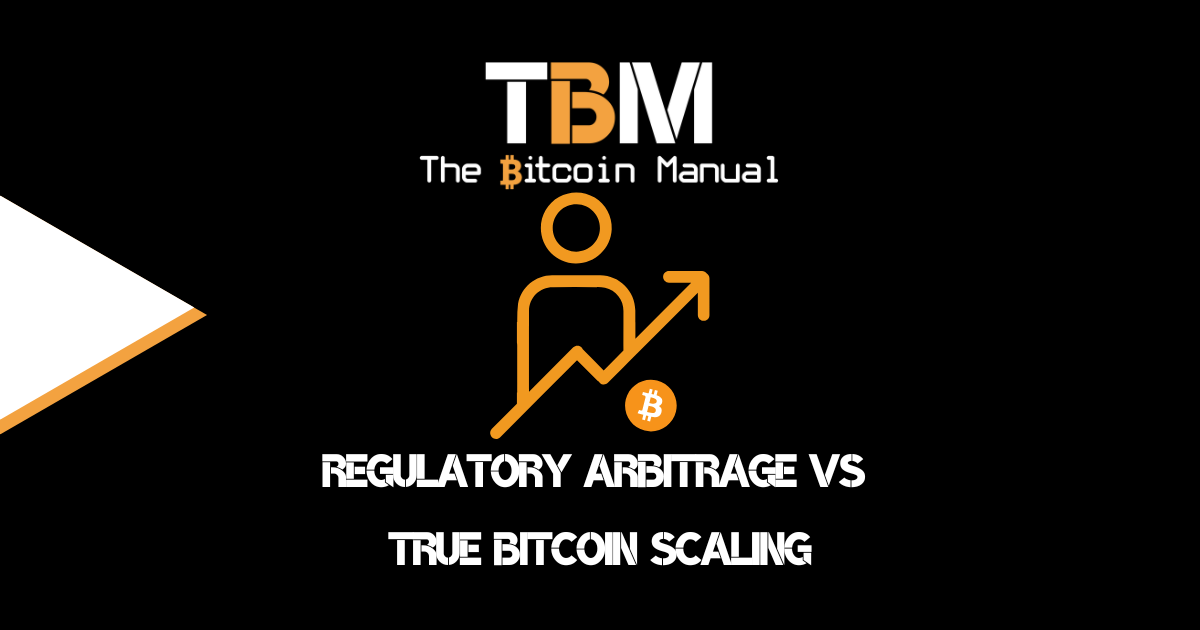If you’re planning on acquiring some Bitcoin, or you’ve already bought Bitcoin, chances are you conducted the transaction with a Centralised Exchange (CEX). These companies act as intermediaries between buyers and sellers, who trade in real-time in different parts of the world.
Instead of trading on-chain and P2P, users would hand over custody of their Bitcoin or fiat to the exchange and, through their internal market, make trades backed by those funds. When a user is happy with their trades, they can request a withdrawal from the service provider.
This simple business model is a thriving business that drives scale, more efficient markets and better price discovery as long as you’re willing to take custody risk and hand over personal information to play in their walled garden.
Exchanges are some of the biggest beneficiaries of the growing popularity of Bitcoin and the broader altcoin market. What started out as a business to help onboard people into Bitcoin by acting as a custodian that would accept liability for fiat deposits to gain access to Bitcoin has mushroomed into one that would sell you any token under the sun as long as there are fees to be earned or profiting from pre-mined tokens.
Today exchanges play an essential role as the gateway to these so-called grey markets worldwide, selling Bitcoin alongside an evergrowing list of unregistered securities, and many of them have built multimillion or even billion-dollar businesses off it.
Despite the billions poured into the space and the returns exchanges can net on assets under management due to the speculative frenzy of trading these assets, some Centralised Exchanges get greedy or caught up in criminal activity. We’ve seen several Centralised Exchanges fold over the years, some with a whimper while others implode spectacularly in a blaze of fraud, corruption, negligence or general bad practices.
Exchanges are always at risk.
Fraud or criminality in exchanges often gets all the headlines, but it’s not the only way these businesses can wind up as a marked failure on a certain Bitcoin block height. Even if centralised exchanges keep their operations and noses squeaky clean or just caught with a bit of white powder on the tip, these businesses still face many risks they must constantly mitigate.
- Security risks: Cryptocurrency exchanges are often targeted by hackers, who seek to steal user funds. As of 2022, over $3 billion worth of cryptocurrencies were stolen from exchanges.
- Liquidity risks: Cryptocurrency exchanges need to have enough liquidity to meet the demands of their users. If an exchange does not have enough liquidity, it may not be able to process withdrawals or trades quickly or efficiently.
- Counterparty risks: When users deposit funds into an exchange, they trust the exchange to hold their funds securely. If the exchange becomes insolvent through rehypothecation practices or duration risk, users may lose their funds through a bank run.
- Market risks: The cryptocurrency market is volatile, and the value of cryptocurrencies can fluctuate wildly. This can create losses for exchanges, as they may need more time to sell their cryptocurrencies to avoid losses.
- Regulatory risks: The cryptocurrency industry is still in its early stages of development, and regulations are evolving rapidly. This can create uncertainty for exchanges, as they may need to be sure what rules to comply with.
Out of all the risks, Centralised Exchanges are most worried about regulatory risk. The harder it is to comply with listing and selling tokens, the less margin they make on certain assets and trading pairs; the harder it is to comply, the harder it is to list more tokens to sell to retail customers. The more regulation, the less chance exchanges can avoid fines or lawsuits.
Exchanges are expanding their remit.
As regulators begin to lay down a framework for altcoins, exchanges will not sit around and wait to hear their fate; they will be proactive. Like any business, exchanges face risks and will look at ways of protecting their market share and revenue and growing it too.
Instead of only relying on the internal markets they created, which will eventually fall under regulation, exchanges are looking to partition some of their current profitable practices and move them off-site. Exchange chains are a natural business model progression, allowing these players to have a consumer-facing business that complies but acts as a funnel to the backdoor where anything goes.
Exchange chains are a hot topic in the industry, and the trend will continue for a long time with a few platforms leading the charge, namely:
- Binance – Binance Chain And Binance SmartChain
- Crypto.com – Cronos Chain
- OKex – OKChain
- Huobi – HECO Chain
- CoinBase – Base Chain
- Bithumb – Bithumb Chain (In Development)
What’s in it for exchanges?
There are several reasons why cryptocurrency exchanges are starting to launch their chains.
Reducing risk on third-party chains
One reason is that they want more control over their infrastructure and reduce possible downtime that can lead to loss of revenue. When exchanges rely on third-party blockchains, they are at the mercy of those blockchains’ developers and miners; if those chains go down, as is the case with altcoins like Solana, or if a chain or bridge is attacked and chains are paused, this can affect an exchange.
In addition, third-party blockchains can be slow, expensive, and insecure, and a single dApp can bring a chain to its knees if it becomes popular, as we saw with Ethereum and CryptoKitties or Bored Apes.
By launching their own chains, exchanges can ensure that they have a more reliable and efficient infrastructure.
Access to wider markets
Another reason cryptocurrency exchanges are launching their own chains is to create new opportunities for access to capital and profit on assets under management.
For example, exchanges can use their own chains to support new types of decentralised applications (dApps) with their own altcoin; while that altcoin couldn’t be registered on the Exchange proper, it’s allowed to trade on-chain.
Partnering with stablecoin providers was a great way for exchanges to generate new income and liquidity and avoid slow fiat on-ramps, but why share the revenue with those service providers and third-party chains when you can be the chain and either run your own stablecoin or get a better deal from getting stablecoin providers to issue on your chain.
This way, you’re not wasting funds on paying third-party chain fees to move stablecoins, and you can pocket that revenue for yourself.
Exchanges make money when you deposit money with them and trade or use their products; the moment you pull your money from the Exchange, they get nothing from it other than the last withdrawal fee. Instead of letting you go that easy, they can also offer you the use of their chains to offer faster and cheaper transactions. This could make it easier for users to trade cryptocurrencies, use dApps, and, of course, net the Exchange more fees on your funds.
Reducing market share for the competition
Cryptocurrency exchanges are launching their chains to compete with each other. In the past, Exchanges competed based on the fees they charged and the number of cryptocurrencies they listed. However, as the industry matures, exchanges realise that they need to offer more than just basic services. By launching their own chains, exchanges can differentiate themselves from their competitors and attract new users.
The trend of cryptocurrency exchanges launching their chains is still in its early stages. Still, it is likely to continue in the years to come, and those who can create a moat where users remain in their ecosystem for longer can drive higher customer lifetime value and keep these fickle users from jumping to the competition.
Bitcoin and stablecoins upfront, shitcoins in the back.
As an exchange that wants to comply with regulation so you have access to certain capital markets, your revenue generation will be limited within your internal trading engine, along with the products you’re allowed to market to customers.
However, if you have a chain, you can sell individuals on stablecoins or wrapped Bitcoin, which seemingly comply with regulation and then provide a grey market of AMMs, lending & borrowing services, Play to Earn games, NFT marketplaces and other ecosystem projects to use those funds.
You’re not running those casinos; that’s the “community” and developers “innovating” on top of your technology; you just so happen to own the rails they work on and profit from every transaction on those rails.
Profiting from MEV
Despite claiming or feigning decentralisation, exchange chains are highly centralised. While you might see different nodes and validators as part of the infrastructure, do you think an exchange will allow anyone from an open community to compete with them on their network for block validation and fees?
Exchange chains might claim to be public blockchains, but they operate as a consortium of private chains. The number of nodes is not enough to offer any meaningful qualities of decentralisation, nor is the number of block validators enough to even claim a semblance of distribution.
Although some of these chains claim to be open to the community to operate nodes and validate blocks, this competition can easily be mitigated by adding higher requirements or high staking thresholds to discourage involvement.
So now that you’re the only operator in town, you have a complete say in how blocks are created and propagated on the network, meaning you have free reign on any MEV opportunities on your chain. Instead of only being able to wreck those trading on your order book, you can profit from those who are using any automatic market maker/DEX on your chain, anyone taking loans on your chain, and even the average person sending funds between parties.
As regulators catch up, the times, they are a-changing.
Staying ahead of regulation allows Exchanges to profit from regulatory arbitrage and grey markets. Since Bitcoin and altcoins are a global market, exchanges can leverage loopholes and exploit differences in rules between jurisdictions to gain an advantage.
This cat-and-mouse game has existed for years, even before exchange chains became part of the conversation. A previous example of these activities is Exchanges that are set up offshore; while they cannot have certain countries’ bank accounts, they could still accept dollar deposits through stablecoins or allow deposits in Bitcoin that are used to create stablecoins or back a synthetic stablecoin.
Exchanges also tend to set up shops in a jurisdiction with lax regulations and offer services not allowed in other jurisdictions and claim to enforce rules to stop users from accessing their services in those blacklisted markets, but in theory, they know a VPN allows them plausible deniability.
Exchanges thrive in these grey markets, and they won’t give it up without a fight. Considering the amount of money they make and stand to make, putting up technological and legal barriers between them and regulators is a worthwhile cost, no matter how complex.
Regulatory arbitrage and grey markets are risky activities, and some might be able to avoid legal action for many years, but that doesn’t mean they’ll always remain ahead of the curve.




